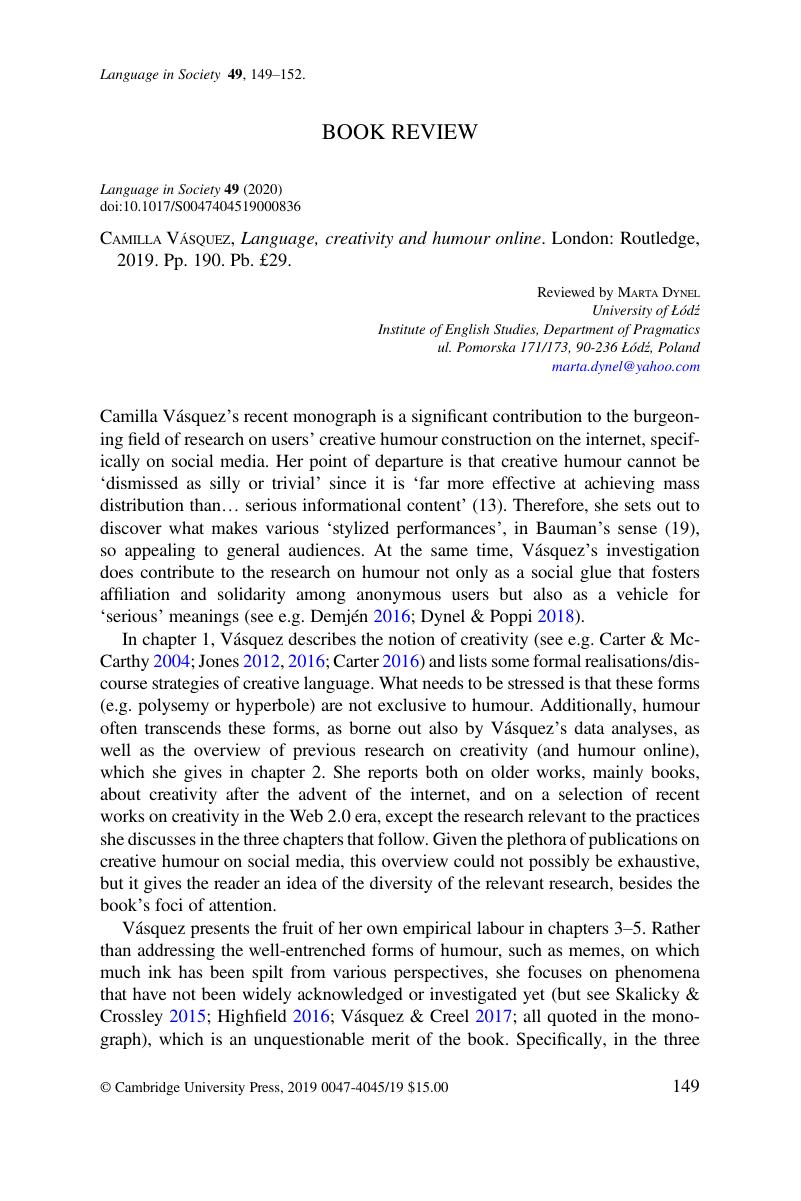No CrossRef data available.
Article contents
Camilla Vásquez, Language, creativity and humour online. London: Routledge, 2019. Pp. 190. Pb. £29.
Published online by Cambridge University Press: 28 November 2019
Abstract
An abstract is not available for this content so a preview has been provided. Please use the Get access link above for information on how to access this content.

- Type
- Book Review
- Information
- Copyright
- Copyright © Cambridge University Press 2019
References
Carter, Ronald (2016). Language and creativity: The art of common talk. 2nd edn. London: Routledge.Google Scholar
Carter, Ronald, & McCarthy, Michael (2004). Talking, creating: Interactional language, creativity and context. Applied Linguistics 25(1):62–88.10.1093/applin/25.1.62CrossRefGoogle Scholar
Chovanec, Jan (2012). Conversational humour and joint fantasizing in online journalism. In Chovanec, Jan & Ermida, Isabel (eds.), Language and humour in the media, 139–61. Newcastle: Cambridge Scholars.Google Scholar
Demjén, Zsofia (2016). Laughing at cancer: Humour, empowerment, solidarity and coping online. Journal of Pragmatics 101:18–30.10.1016/j.pragma.2016.05.010CrossRefGoogle Scholar
Demjén, Zsofia (2018). Complexity theory and conversational humour: Tracing the birth and decline of a running joke in an online cancer support community. Journal of Pragmatics 133:93–104.10.1016/j.pragma.2018.06.001CrossRefGoogle Scholar
Dynel, Marta (2013). When does irony tickle the hearer? Towards capturing the characteristics of humorous irony. In Dynel, Marta (ed.), Developments in linguistic humour theory, 298–320. Amsterdam: John Benjamins.10.1075/thr.1CrossRefGoogle Scholar
Dynel, Marta, & Poppi, Fabio I. M. (2018). In tragoedia risus: Analysis of dark humour in post-terrorist attack discourse. Discourse & Communication 12(4):382–400.10.1177/1750481318757777CrossRefGoogle Scholar
Dynel, Marta, & Poppi, Fabio I. M. (2019a). Risum teneatis, amici? The socio-pragmatics of RoastMe humour. Journal of Pragmatics 139:1–21.10.1016/j.pragma.2018.10.010CrossRefGoogle Scholar
Dynel, Marta, & Poppi, Fabio I. M. (2019b). Arcana imperii: The power of humorous retorts to insults on Twitter. Journal of Language Aggression and Conflict, DOI: https://doi.org/10.1075/jlac.00031.dynCrossRefGoogle Scholar
Dynel, Marta, & Poppi, Fabio I. M. (2020). Quid rides? Targets and referents of RoastMe insults. Humor, to appear.Google Scholar
Forabosco, Giovannantonio (1992). Cognitive aspects of the humour process: The concept of incongruity. Humor 5:9–26.10.1515/humr.1992.5.1-2.45CrossRefGoogle Scholar
Highfield, Tim (2016). News via Voldemort: Parody accounts in topical discussions on Twitter. New Media & Society 18(9):2028–45.10.1177/1461444815576703CrossRefGoogle Scholar
Jones, Rodney H. (2012). Introduction: Discourse and creativity. In Jones, Rodney (ed.), Discourse and creativity, 1–14. Harlow: Pearson.Google Scholar
Jones, Rodney H. (ed.) (2016). The Routledge handbook of language and creativity. London: Routledge.Google Scholar
Martin, Rod, & Ford, Thomas (2018). The psychology of humour: An integrative approach. Burlington: Elsevier.Google Scholar
Skalicky, Stephen, & Crossley, Scott (2015). A statistical analysis of satirical Amazon.com product reviews. European Journal of Humor Research 2:66–85.10.7592/EJHR2014.2.3.skalickiCrossRefGoogle Scholar
Suls, Jerry (1972). A two-stage model for the appreciation of jokes and cartoons: An information processing analysis. In Goldstein, Jerry & McGhee, Paul (eds.), The psychology of humor, 81–100. New York: Academic Press.10.1016/B978-0-12-288950-9.50010-9CrossRefGoogle Scholar
Tsakona, Villy (2018). Online joint fictionalization. In Tsakona, Villy & Chovanec, Jan (eds.), The dynamics of interactional humor: Creating and negotiating humor in everyday encounters, 229–55. Amsterdam: John Benjamins.10.1075/thr.7.10tsaCrossRefGoogle Scholar
Vásquez, Camilla, & Creel, Samantha (2017). Conviviality through creativity: Appealing to the reblog in Tumblr Chat posts. Discourse, Context & Media 20:59–69.10.1016/j.dcm.2017.08.005CrossRefGoogle Scholar




